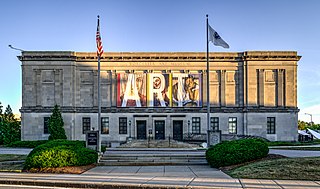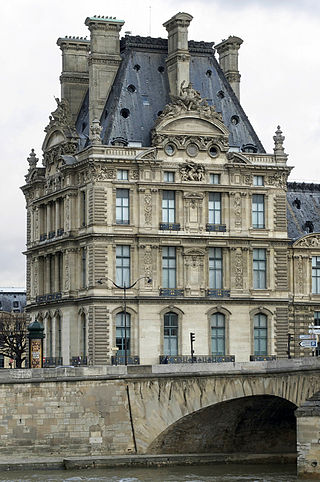
The Louvre, or the Louvre Museum, is a national art museum in Paris, France. It is located on the Right Bank of the Seine in the city's 1st arrondissement and home to some of the most canonical works of Western art, including the Mona Lisa and the Venus de Milo. The museum is housed in the Louvre Palace, originally built in the late 12th to 13th century under Philip II. Remnants of the Medieval Louvre fortress are visible in the basement of the museum. Due to urban expansion, the fortress eventually lost its defensive function, and in 1546 Francis I converted it into the primary residence of the French Kings.

The Venus de Milo or Aphrodite of Melos is an ancient Greek marble sculpture that was created during the Hellenistic period. Dating is uncertain, but the modern consensus places it in the 2nd century BC, perhaps between 160 and 110 BC. It was rediscovered in 1820 on the island of Milos, Greece, and has been displayed at the Louvre Museum since 1821. Since the statue's discovery, it had become one of the most famous works of ancient Greek sculpture in the world.

In Greek mythology, the Charites, singular Charis, or Graces, were three or more goddesses of charm, beauty, nature, human creativity, goodwill, and fertility. Hesiod names three – Aglaea ("Shining"), Euphrosyne ("Joy"), and Thalia ("Blooming") – and names Aglaea as the youngest and the wife of Hephaestus. In Roman mythology they were known as the Gratiae, the "Graces". Some sources use the appellation "Charis" as the name of one of the Charites, and equate her with Aglaea, as she too is referred to as the wife of Hephaestus.

The Musée de Cluny, officially Musée de Cluny-Musée National du Moyen Âge, is a museum of medieval art in Paris. It is located in the 5th arrondissement of Paris, bordered by square Samuel-Paty to the south, boulevard Saint-Michel to the west, boulevard Saint-Germain to the north, and rue Saint-Jacques to the east.

The Siphnian Treasury was a building at the Ancient Greek cult centre of Delphi, erected to host the offerings of the polis, or city-state, of Siphnos. It was one of a number of treasuries lining the "Sacred Way", the processional route through the Sanctuary of Apollo, erected to win the favor of the gods and increase the prestige of the donor polis. It was one of the earlier surviving buildings of this type, and its date remains a matter for debate, with the most plausible date being around 525 BC. Until recently it was often confused or conflated with the neighbouring Cnidian Treasury, a similar but less elaborate building, as the remains of the two had become mixed together and earlier theoretical reconstructions used parts of both.

The Worcester Art Museum (WAM) houses over 38,000 works of art dating from antiquity to the present day and representing cultures from all over the world. WAM opened in 1898 in Worcester, Massachusetts. Its holdings include Roman mosaics, European and American art, and a major collection of Japanese prints. Since acquiring the John Woodman Higgins Armory Collection in 2013, WAM is also home to the second largest collection of arms and armor in the Americas.

Venus Anadyomene is one of the iconic representations of the goddess Venus (Aphrodite), made famous in a much-admired painting by Apelles, now lost, but described in Pliny's Natural History, with the anecdote that the great Apelles employed Campaspe, a mistress of Alexander the Great, for his model. According to Athenaeus, the idea of Aphrodite rising from the sea was inspired by the courtesan Phryne, who, during the time of the festivals of the Eleusinia and Poseidonia, often swam nude in the sea. A scallop shell, often found in Venus Anadyomenes, is a symbol of the female vulva.

The Musée du Quai Branly – Jacques Chirac, located in Paris, France, is a museum designed by French architect Jean Nouvel to feature the indigenous art and cultures of Africa, Asia, Oceania, and the Americas. The museum collection comprises more than a million objects, of which 3,500 are on display at any given time, in both permanent and temporary thematic exhibits. A selection of objects from the museum is also displayed in the Pavillon des Sessions of the Louvre.

The House of the Tragic Poet is a Roman house in Pompeii, Italy dating to the 2nd century BCE. The house is famous for its elaborate mosaic floors and frescoes depicting scenes from Greek mythology.

The Pavillon de Flore, part of the Palais du Louvre in Paris, France, stands at the southwest end of the Louvre, near the Pont Royal. It was originally constructed in 1607–1610, during the reign of Henry IV, as the corner pavilion between the Tuileries Palace to the north and the Louvre's Grande Galerie to the east. The pavilion was entirely redesigned and rebuilt by Hector Lefuel in 1864–1868 in a highly decorated Napoleon III style. Arguably the most famous sculpture on the exterior of the Louvre, Jean-Baptiste Carpeaux's Triumph of Flora, was added below the central pediment of the south facade at this time. The Tuileries Palace was burned by the Paris Commune in 1871, and a north facade, similar to the south facade, was added to the pavilion by Lefuel in 1874–1879. Currently, the Pavillon de Flore is part of the Musée du Louvre.

The Bardo National Museum is a museum of Tunis, Tunisia, located in the suburbs of Le Bardo.

A Roman mosaic is a mosaic made during the Roman period, throughout the Roman Republic and later Empire. Mosaics were used in a variety of private and public buildings, on both floors and walls, though they competed with cheaper frescos for the latter. They were highly influenced by earlier and contemporary Hellenistic Greek mosaics, and often included famous figures from history and mythology, such as Alexander the Great in the Alexander Mosaic.

The Antioch mosaics are a grouping of over 300 mosaic floors created around the 3rd century AD, and discovered during archaeological excavations of Antioch between 1932 and 1939 by a consortium of five museums and institutions. About half of the mosaics are now in the Hatay Archaeology Museum in Antakya, with the rest in the Worcester Art Museum, Museum of Fine Arts, Boston, Baltimore Museum of Art, Harvard University and Princeton University Art Museum among others. The mosaics range in design from realistic imagery and scenes to purely geometric patterns.

The MACM, the Mougins Museum of Classical Art, private museum inaugurated in June 2011 in the village of Mougins in the Alpes-Maritimes department, France has closed its doors in August 2023 to make way for a new museum, FAMM opening in June 2024.

For centuries, Paris has attracted artists from around the world, arriving in the city to educate themselves and to seek inspiration from its artistic resources and galleries. As a result, Paris has received a reputation as the "City of Art". Home to some of the world's most famous museums and galleries, including the Louvre and the Musée d'Orsay, the city today remains home to a thriving community of artists. Paris is recognized globally for its public landmarks and masterpieces of architecture including the Arc de Triomphe and a symbol of France, the Eiffel Tower.

The Exaltation of the Flower is the modern title given to an early Classical Greek marble fragment of a funerary stele from the 5th century BCE. It was discovered in 1861 by Léon Heuzey and Honoré Daumet at a church in Farsala, Thessaly, Greece. Carved in bas-relief in the severe style, the extant upper fragment of the marble relief stele depicts two women holding what appear to be flowers or other objects. The work is held by the Louvre museum in the Department of Greek, Etruscan, and Roman Antiquities.

The Judgement of Paris Amphora is an Attic black-figure amphora named for the scene depicted on it. It is held by the Musée des beaux-arts de Lyon with the inventory number E 581-c and is attributed to the London B76 Painter, who was active at Athens in the second quarter of the sixth century BC.

The Worcester Hunt Mosaic is a large Byzantine floor mosaic located at Worcester Art Museum in Worcester, Massachusetts. The mosaic was originally constructed for an upscale villa in Daphne, just outside of Antioch. The mosaic was discovered during an archeological expedition which lasted between 1932 and 1939. It is currently the largest Antioch mosaic located within the United States. It measures approximately 20.5 feet x 23.3 feet.
The Grand Louvre refers to the decade-long project initiated by French President François Mitterrand in 1981 of expanding and remodeling the Louvre – both the building and the museum – by moving the French Finance Ministry, which had been located in the Louvre's northern wing since 1871, to a different location. The centerpiece of the Grand Louvre is the Louvre Pyramid designed by Chinese-American architect I. M. Pei, which was also the project's most controversial component. The Grand Louvre was substantially completed in the late 1990s, even though its last elements were only finalized in the 2010s.

The Judgement of Paris is an oil-on-canvas mythological painting by the French artist François Boucher. It was painted c. 1763 and belongs to the Musée des Beaux-Arts of Mulhouse, France. Its inventory number is 61.1.16.




















